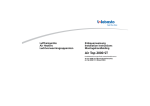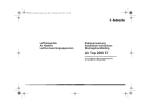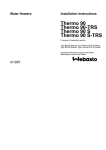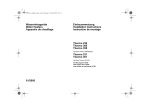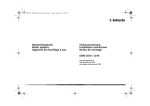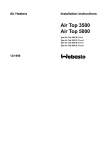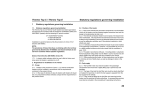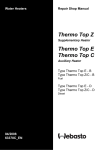Download Webasto Thermo 90-ADR Technical data
Transcript
Wasserheizgeräte Water Heaters Chauffages à eau Einbauanweisung Installation Instructions Instructions de montage Thermo 90 S Thermo 90 ST Thermo 90 S Thermo 90 S Thermo 90 S-ADR 05/2008 1301494C (Benzin) (Petrol) (Essence) (Diesel) (Gas-oil) (Gefahrguttransport) (Transport of hazardous goods) (Transport de marchandises dangereuses) Thermo 90 ST (Benzin) (Petrol) (Essence) Thermo 90 ST (Diesel) (Gas-oil) Thermo 90 ST-ADR (Gefahrguttransport) (Transport of hazardous goods) (Transport de marchandises dangereuses) Das unsachgemäße Einbauen oder Reparieren von Webasto Heiz- und Kühlsystemen kann Feuer verursachen oder zum Austritt von tödlichem Kohlenmonoxid führen. Dadurch können schwere oder tödliche Verletzungen hervorgerufen werden. Für den Einbau und die Reparatur von Webasto Heiz- und Kühlsystemen bedarf es eines Webastotrainings, technischer Dokumentation, Spezialwerkzeuge und einer Spezialausrüstung. Versuchen Sie NIEMALS, Webasto Heiz- oder Kühlsysteme einzubauen oder zu reparieren, wenn Sie das Webastotraining nicht erfolgreich abgeschlossen und dabei die notwendigen technischen Fähigkeiten erworben haben und die für einen sachgerechten Einbau und Reparatur nötigen technischen Dokumentationen, Werkzeuge und Ausrüstungen nicht zur Verfügung stehen. Befolgen Sie IMMER alle Webasto Einbau- und Reparaturanleitungen, und beachten Sie alle Warnhinweise. Webasto übernimmt keine Haftung für Mängel und Schäden, die auf einen Einbau durch ungeschultes Personal zurückzuführen sind. Improper installation or repair of Webasto heating and cooling systems can cause fire or the leakage of deadly carbon monoxide leading to serious injury or death. To install and repair Webasto heating and cooling systems you need to have completed a Webasto training course and have the appropriate technical documentation, special tools and special equipment. NEVER try to install or repair Webasto heating or cooling systems if you have not completed a Webasto training course, you do not have the necessary technical skills and you do not have the technical documentation, tools and equipment available to ensure that you can complete the installation and repair work properly. ALWAYS carefully follow Webasto installation and repair instructions and heed all WARNINGS. Webasto rejects any liability for problems and damage caused by the system being installed by untrained personnel. La réparation ou l’installation impropre des systèmes de chauffage et de refroidissement Webasto peut conduire à l’incendie de l’appareil ou encore à des fuites mortelles de monoxyde de carbone pouvant entraîner de graves lésions voire même la mort. Pou l’installation ou la réparation des systèmes de chauffage ou de refroidissement Webasto, il est nécessaire d’avoir une formation Webasto, une documentation technique, des outils spécifique et des équipements particuliers. N’essayez JAMAIS d’installer ou de réparer un système de chauffage ou de refroidissement Webasto si vous n’avez pas suivi avec succès la formation Webasto et obtenu ainsi les capacités techniques indispensables et si vous ne disposez pas de la documentation technique, des outils et des équipements nécessaires à une installation ou à une réparation dans les règles de l’art. TOUJOURS suivre scrupuleusement les instructions Webasto relatives à l’installation et à la réparation des appareils et tenir compte de toutes les MISES EN GARDE. Webasto décline toute responsabilité en cas de problème ou de dommage causé par un système ayant été installé par du personnel non qualifié. Thermo 90 S / Thermo 90 ST Inhaltsverzeichnis Table of contents 1 2 3 4 5 6 7 8 9 10 11 12 13 1 2 3 4 5 6 7 8 9 10 11 12 13 Gesetzliche Bestimmungen für den Einbau ´ . . . . . . . . . . . 1 Verwendung / Ausführung . . . . . . . . . . . . . . . . . . . . . . . . . . 4 Einbau . . . . . . . . . . . . . . . . . . . . . . . . . . . . . . . . . . . . . . . . . . 5 Einbaubeispiele . . . . . . . . . . . . . . . . . . . . . . . . . . . . . . . . . . . 6 Anschluss an das Kühlsystem des Fahrzeuges . . . . . . . . 7 Brennstoffversorgung . . . . . . . . . . . . . . . . . . . . . . . . . . . . . 8 Brennluftversorgung . . . . . . . . . . . . . . . . . . . . . . . . . . . . . . 13 Abgasleitung . . . . . . . . . . . . . . . . . . . . . . . . . . . . . . . . . . . . 14 Elektrische Anschlüsse . . . . . . . . . . . . . . . . . . . . . . . . . . . 15 Schaltpläne . . . . . . . . . . . . . . . . . . . . . . . . . . . . . . . . . . . . . 17 Erstinbetriebnahme . . . . . . . . . . . . . . . . . . . . . . . . . . . . . . . 28 Störungen . . . . . . . . . . . . . . . . . . . . . . . . . . . . . . . . . . . . . . 29 Technische Daten . . . . . . . . . . . . . . . . . . . . . . . . . . . . . . . . 31 Statutory regulations governing installation . . . . . . . . . . Use / version . . . . . . . . . . . . . . . . . . . . . . . . . . . . . . . . . . . . Installation . . . . . . . . . . . . . . . . . . . . . . . . . . . . . . . . . . . . . . Examples for installation . . . . . . . . . . . . . . . . . . . . . . . . . . Connection to the vehicle cooling system . . . . . . . . . . . . Fuel supply . . . . . . . . . . . . . . . . . . . . . . . . . . . . . . . . . . . . . Combustion air supply . . . . . . . . . . . . . . . . . . . . . . . . . . . . Exhaust pipe . . . . . . . . . . . . . . . . . . . . . . . . . . . . . . . . . . . . Electrical connections . . . . . . . . . . . . . . . . . . . . . . . . . . . . Circuit diagrams . . . . . . . . . . . . . . . . . . . . . . . . . . . . . . . . . Initial start-up . . . . . . . . . . . . . . . . . . . . . . . . . . . . . . . . . . . Troubleshooting . . . . . . . . . . . . . . . . . . . . . . . . . . . . . . . . . Technical data . . . . . . . . . . . . . . . . . . . . . . . . . . . . . . . . . . . 35 38 39 40 41 42 47 48 49 51 62 63 65 I Thermo 90 S / Thermo 90 ST 1 Statutory regulations governing installation Statutory regulations governing installation 1.1. Statutory regulations governing installation The Thermo 90 S / Thermo 90 ST heater has been type-tested and approved in accordance with EC Directives 72/245/EEC (EMC), 2001/ 56/EC (heater) and ECE R122 with the following EC permit numbers: e1*2001/56*2004/78*0005*-e1*72/245*95/54*1173*-e1*2001/56*2004/78*0019*-E1 R122 00 0217 Primarily the regulations of Annex VII of the Directive 2001/56/EG and Part 2 or Annex 7 of the directive ECE R122 must be observed for the installation. NOTE: The provisions of these Directives are binding within the territory governed by EU Directive 70/156/EEC and should similarly be observed in countries without specific regulations. IMPORTANT Failure to follow the installation instructions and the notes contained therein will lead to all liability being refused by Webasto. The same applies if repairs are carried out incorrectly or with the use of parts other than genuine spare parts. This will result in the invalidation of the type approval for the heater and therefore of its homologation / EC type licence. (Extract from Directive 2001/56/EC Annex VII) 1.7.1. A clearly visible tell-tale in the operator's field of view shall inform when the combustion heater is switched on or off. 2. Vehicle installation requirements 2.1. Scope 2.1.1.Subject to paragraph 2.1.2, combustion heaters shall be installed according to the requirements of this Annex. 2.1.2.Vehicles of category O (trailers) having liquid fuel heaters are deemed to comply with the requirements of this Annex. 2.2. Positioning of heater 2.2.1. Body sections and any other components in the vicinity of the heater must be protected from excessive heat and the possibility of fuel or oil contamination. 2.2.2. The combustion heater shall not constitute a risk of fire, even in the case of overheating. This requirement shall be deemed to be fulfilled if the installation ensures an adequate distance to all parts and suitable ventilation, by the use of fire resistant materials or by the use of heat shields. 2.2.3. In the case of M2 and M3 vehicles, the heater must not be positioned in the passenger compartment. However, an installation in an effectively sealed envelope which also complies with the conditions in paragraph 2.2.2 may be used. 2.2.4. The label referred to in paragraph 1.4 (model plate), or a duplicate (duplicate model plate), must be positioned so that it can be easily read when the heater is installed in the vehicle. 35 Statutory regulations governing installation 2.2.5 Every reasonable precaution should be taken in positioning the heater to minimise the risk of injury and damage to personal property. 2.3. Fuel supply 2.3.1. The fuel filler must not be situated in the passenger compartment and must be provided with an effective cap to prevent fuel spillage. 2.3.2. In the case of liquid fuel heaters, where a supply separate to that of the vehicle is provided, the type of fuel and its filler point must be clearly labelled. 2.3.3. A notice, indicating that the heater must be shut down before refuelling, must be affixed to the fuelling point. In addition a suitable instruction must be included in the manufacturer's operating manual. 2.4. Exhaust system 2.4.1. The exhaust outlet must be located so as to prevent emissions from entering the vehicle through ventilators, heated air inlets or opening windows. 2.5. Combustion air inlet 2.5.1. The air for the combustion chamber of the heater must not be drawn from the passenger compartment of the vehicle. 2.5.2. The air inlet must be so positioned or guarded that blocking by rubbish or luggage is unlikely. 2.6. Heating air inlet 2.6.1. The heating air supply may be fresh or recirculated air and must be drawn from a clean area not likely to be contaminated by exhaust fumes emitted either by the propulsion engine, the combustion heater or any other vehicle source. 2.6.2. The inlet duct must be protected by mesh or other suitable means. 36 Thermo 90 S / Thermo 90 ST 2.7. Heating air outlet 2.7.1. Any ducting used to route the hot air through the vehicle must be so positioned or protected that no injury or damage could be caused if it were to be touched. 2.7.2. The air outlet must be so positioned or guarded that blocking by rubbish or luggage is unlikely. 2.8. Automatic control of the heating system The heating system must be switched off automatically and the supply of fuel must be stopped within five seconds when the vehicle's engine stops running. If a manual device is already activated, the heating system can stay in operation. NOTE: Contrary to point 2.2.3 the heater must also not be installed in the passenger cabin of class M1 and N vehicles. However, an installation in an effectively sealed envelope which also complies with the conditions in paragraph 2.2.2 may be used. Thermo 90 S / Thermo 90 ST Statutory regulations governing installation (Extract from Directive 2001/56/EC Annex IX) 3. Technical specifications for heater units for installation in dangerous goods transporters (Annex 9) 3.1. General (EX/II, EX/III, AT, FL and OX vehicles) 3.1.1. The combustion heaters and their exhaust gas routing shall be designed, located, protected or covered so as to prevent any unacceptable risk of heating or ignition of the load. This requirement shall be considered as fulfilled if the fuel tank and the exhaust system of the appliance conform to the provisions set out in the points 3.1.1.1 and 3.1.1.2. Compliance with those provisions shall be verified on the completed vehicle. 3.2. EX/II and EX/III vehicles Combustion heaters using gaseous fuels are not permitted. 3.3. FL vehicles 3.3.1. The combustion heaters shall be put out of operation by at least the following methods: a) intentional manual switching off from the driver’s cab; b) stopping of the vehicle engine; in this case the heating device may be restarted manually by the driver; c) start-up of a feed pump on the motor vehicle for the dangerous goods carried. 3.1.1.1. Any fuel tanks for supplying the appliance shall meet the following requirements: a) in the event of any leakage, the fuel shall drain to the ground without coming into contact with hot parts of the vehicle or the load; b) fuel tanks containing petrol shall be equipped with an effective flame trap at the filler opening or with a closure enabling the opening to be kept hermetically sealed. 3.1.1.2. The exhaust system as well as the exhaust pipes shall be so directed or protected to avoid any danger to the load through heating or ignition. Parts of the exhaust system situated directly below the fuel tank (diesel) shall have a clearance of at least 100 mm or be protected by a thermal shield. 3.1.2. The combustion heater shall be switched on manually. Programming devices shall be prohibited. 37 Use / version 2 Thermo 90 S / Thermo 90 ST Use / version 2.1. Use of the water heaters The Webasto water heater is used in connection with the vehicle's own heating system – to heat the cab, – to defrost the vehicle windows and – to preheat water-cooled engines. The water heater operates independently of the engine and is connected to the cooling system, the fuel system and the electrical system of the vehicle. The Thermo 90 S and Thermo 90 ST heaters differ from each other in their component plug and in the fact that they have different control modules. 2.2. 2.2.1. Versions Thermo 90 S version Thermo 90 S petrol Water heater for "petrol" fuel Thermo 90 S diesel Water heater for "diesel" fuel The water heaters are designed for 12 V (Thermo 90 S petrol) and for 12 or 24 V (Thermo 90 S diesel). 2.2.2. Thermo 90 ST version Thermo 90 ST petrol Water heater for "petrol" fuel Thermo 90 ST diesel Water heater for "diesel" fuel The water heaters are designed for 12 V (Thermo 90 ST petrol) and for 12 or 24 V (Thermo 90 ST diesel). 38 Thermo 90 S / Thermo 90 ST 3 Installation Installation IMPORTANT – The water heater must be installed outside the passenger cabin. – The requirements of the latest version of the ADR must also be observed for the installing the heater into vehicles used to transport hazardous substances. NOTE: If the vehicle manufacturer has issued instructions, they must be followed. 3.2. To install the heater The heater must be secured with at least three M8 screws. The screws must be tightened with a torque of 18 Nm. 3.3. Model plate The model plate must be positioned so that it cannot be damaged and must be clearly legible when the heater is installed (otherwise a duplicate model plate must be used). Inapplicable years must be erased from the model plate. 3.1. Installation site / Installation position The heater must be installed in as low a position as possible to allow the heater and circulating pump to be bled automatically. This is particularly important as the circulating pump is not self-priming. Fig. 1: Permitted installation positions for the Thermo 90 S / Thermo 90 ST 39 Examples for installation 4 Thermo 90 S / Thermo 90 ST Examples for installation Wiring harness Fuel line Exhaust line Water circuit Fig. 2: 1 2 3 4 5 6 40 Without non-return valve Installation example for the Thermo 90 S / Thermo 90 ST heater Heat exchanger, car’s heating system Switch for car’s heating system fan Relay for vehicle fan Digital timer Fuse strip in the car Non-return valve with leakage hole 7 8 9 10 11 12 13 T-piece Vehicle engine Heater Circulating pump Water pump Radiator Regulating valve With non-return valve and thermostat 14 15 16 17 18 19 Exhaust silencer Metering pump Combustion air intake line Thermostat Control module (optional on the Thermo 90 S) Control module (installation position of the Thermo 90 ST and optional for the Thermo 90 S) Thermo 90 S / Thermo 90 ST 5 Connection to the vehicle cooling system Connection to the vehicle cooling system In thermostat circuits, only use thermostats which start to open at < 65 °C. The heater is connected to the vehicle cooling system as shown in Figure 2. The system must contain at least 6 litres of coolant. The water hoses supplied by Webasto must always be used. If you do not use these hoses, the hoses that you do use must comply with DIN 73411. The hoses must be installed without kinks and (to ensure perfect bleeding) rising if possible. Hose connections must be supported by hose clips to prevent them slipping. NOTE: The hose clips must be tightened with a torque of 4 Nm. The cooling system must be bled carefully before using the heater for the first time or after replacing the coolant. The heater and lines should be installed in such a way as to ensure static bleeding. Perfect ventilation can be identified by the circulating pump operating almost silently. 41 Fuel supply 6 Thermo 90 S / Thermo 90 ST Fuel supply The fuel is taken from the vehicle fuel tank or from a separate fuel tank. The values for the maximum pressure at the fuel extraction point are shown in the table below. Permissible fuel inflow height H (m) At max. pressure (bar) in fuel line 0.00 0.2 1.00 0.11 2.00 0.03 Maximum fuel intake height S (m) At max. negative pressure (bar) in the fuel tank 0.00 -0.10 0.50 -0.06 1.00 -0.02 Only for ADR: The statutory regulation of ADR (Accord européen relatif au transport international des marchandises dangereuses par route) governing fuel tanks, part 9 para. 9.2.4.7, must be adhered to. NOTE: A sign must be affixed to the fuel filler neck warning that the heater must be switched off before refuelling. l1 + l2 ≤ 10 m l2 ≤ 1.2 m l2 ≤ 8.8 m Fig. 3: 42 Fuel supply Thermo 90 S / Thermo 90 ST Fuel supply 6.1. Vehicles with diesel engines The fuel must be taken from the vehicle fuel tank or from a separate tank (see Figs. 4, 5 and 6). Fuel extractor Plastic tank Sealing ring Sealing ring Fig. 5: Tank fittings Fuel pickup from the plastic tank (Pickup via tank drain screw) Hole pattern Only use a tank connector if the fuel tank is made from metal Fig. 4: Fuel pickup from the plastic tank (Pickup via tank fitting) NOTE: Deburr the cut on the tank connector after sawing it off and remove any metal chips. Fig. 6: Webasto tank connector NOTE on Fig. 6: The fitting must be made from metal! 43 Fuel supply Thermo 90 S / Thermo 90 ST 6.2. Vehicles with petrol engines The heater must be integrated into the return line of fuel systems in carburettor and injection engines with a return line. In carburettor engines without a return line the heater must be integrated into the fuel system in the supply line between the fuel tank and the vehicle pump. NOTE A fuel feed line can normally be identified by the fact that a fuel filter is installed in it. NOTE: If there is an evaporation tank in the vehicle’s fuel system, the fuel must be extracted upstream of the evaporation tank. from tank to engine Fuel may only be taken from the supply or return line using the special Webasto fuel extractor (see Figure 7). The fuel extractor must be fitted in such a way that any air or gas bubbles are automatically discharged towards the tank (see Figure 7). Air or gas bubbles may be produced in the vehicle’s fuel line if there are leaks in the carburettor or vehicle fuel pump or if the ambient temperature is higher than the evaporation temperature of the fuel. The fuel extractor must not be located near the engine, as gas bubbles may form in the lines on account of heat radiated from the engine. This may cause problems during combustion. When installing the heater in a vehicle with fuel injection system, it is important to establish whether the fuel pump is located inside or outside the tank. If the fuel pump is located inside the tank, fuel can only be extracted from the return line. In this case it must be ensured that the return line continues almost to the bottom of the tank and is not sealed by a non-return valve. If this is not the case the return line may be extended. 44 to metering pump Fig. 7: Webasto fuel extractor If the fuel pump is installed outside the tank, the fuel connection may be made between the tank and the fuel pump. 6.3. Fuel lines Only steel, copper and plastic lines of plasticised, light and temperaturestabilized PA 11 or PA 12 (e.g. Mecanyl RWTL) pursuant to DIN 73378 may be used for the fuel lines. Thermo 90 S / Thermo 90 ST Fuel supply NOTE: Cut Mecanyl lines without burr and do not crush them. Do not cut them with side-cutting pliers. Correct Clip Since the lines normally cannot be routed with a constant rising gradient, the internal diameter must not be allowed to exceed a certain size. Air or gas bubbles will accumulate in lines with an internal diameter of more than 4 mm and these will cause malfunctions if the lines sag or are routed downwards. The diameters specified in Figures 3 and 7 will ensure that bubbles do not form. The lines should not be routed downwards from the metering pump to the heater. Unsupported fuel lines must be secured to prevent them sagging. They must be installed in such a way that they cannot be damaged by flying chippings and high temperatures (exhaust line). Wrong Bubble Fig. 8: Bubble Pipe / hose connection 12 V and 24 V – petrol and diesel 6.3.1. Connecting two pipes with a hose The correct procedure for connecting fuel lines with hosing is illustrated in Fig. 8. NOTE: Ensure that there are no leaks. 6.4. Metering pump with damper The metering pump is a combined delivery, metering and shutoff system and is subject to specific installation criteria (see Figs. 3, 9 and 10). Fig. 9: 6.4.1. Installation location Before installing the metering pump, ensure that the maximum pressure occurring at the pickup point is less than 0.2 bar. It is advisable to install the metering pump in a cool place. The maximum ambient temperature must not exceed + 20 °C for petrol and + 40 °C for diesel at any time during operation. Metering pump DP2 Installation position and attachment The metering pump and fuel lines must not be installed within range of the radiated heat from hot vehicle parts. A heat shield must be used if necessary. 45 Fuel supply Thermo 90 S / Thermo 90 ST 12 V and 24 V – diesel only 0° - 90° Fig. 11: Fuel filter Fig. 10: Metering pump 30.2 Horizontal installation position The pump should ideally be installed near the tank. 6.4.2. Installation and attachment The metering pump must be secured with a vibration-damping mounting. Its installation position is limited as shown in Figs. 9 and 10 in order to ensure effective auto-bleeding. 6.5. Fuel filter Only a Webasto filter, order no. 487 171, is allowed to be used if the fuel is expected to be contaminated. Install vertically if possible, however at least horizontally. NOTE: Note the installation position and direction of flow. 46 Thermo 90 S / Thermo 90 ST 7 Combustion air supply Combustion air supply Under no circumstances may the combustion air be taken from areas occupied by people. The combustion air intake opening must not point in the direction of travel. It must be located so that it cannot become clogged with dirt or snow and cannot suck in splashing water. The combustion air intake line (internal diameter at least 30 mm) may be 0.5 m to 5 m long with several bends totalling 360°. The minimum bending radius is 45 mm. The combustion air intake must not be routed above the exhaust outlet. NOTE: If the combustion air intake line cannot be installed so that it slopes downwards, a water drain hole with a diameter of 4 mm is to be made at its lowest point. If the heater is installed in a general installation space near the vehicle’s fuel tank, the combustion air must be taken in from the outside and the exhaust fumes discharged into the atmosphere. The openings must be splash-proof. A ventilation opening measuring at least 6 cm2 is required if the heater is installed in an enclosed box. The size of the ventilation opening must be increased accordingly if the temperature in the box exceeds the permitted ambient temperature of the heater (see Technical data). 47 Exhaust pipe 8 Thermo 90 S / Thermo 90 ST Exhaust pipe The exhaust pipe (internal diameter 38 mm) can be installed with a length of 0.5 m to 5 m and several bends (360° altogether, minimum bending radius 85 mm). The exhaust silencer is essential and must be installed near the heater. The opening of the exhaust pipe must not point towards the front of the vehicle (see Figure 12). An attachment is required no further than 150 mm from the end of the exhaust pipe to ensure that the angle of 90° ± 10° is achieved Discharge direction almost vertical 90° ± 10° Fig. 12: Exhaust pipe opening Installation position 48 The exhaust pipe opening must be located so that it cannot become clogged with snow and mud. Rigid pipes of unalloyed or alloyed steel with a minimum wall thickness of 1.0 mm or flexible piping of alloyed steel only must be used as exhaust line. The exhaust pipe is secured to the heater using a clamping collar, for example. See the statutory regulations for other requirements. Only for ADR: The statutory regulation of ADR (Accord européen relatif au transport international des marchandises dangereuses par route) governing the routing of the exhaust line, part 9 para. 9.2.4.7, must be adhered to. Thermo 90 S / Thermo 90 ST 9 Electrical connections Electrical connections 9.1. Control module / heater connection The electrical connection of the heaters is made as shown in the circuit diagrams in Figures 15, 16, 17, 18, 19, 20, 21 and 22. Connection when installing Thermo 90 S-ADR and Thermo 90 ST-ADR in a hazchem vehicle (ADR) To install the Thermo 90 S-ADR and Thermo 90 ST-ADR heaters in hazchem vehicles, the requirements of ADR/RID part 9 para. 9.2.4.7 – Combustion heating systems, must also be satisfied. The electrical connection is made as shown in the circuit diagram, Figs. 17, 18, 21 and 22. the standard clock remains free. The heater can then only be taken into service using the immediate heat button (circuit diagram available on request). The use of other timers in ADR vehicles is not permitted. 9.2. NOTE: The switch S7 must be installed in such a way that a positive potential is connected to appropriate input of the control module when a pumping device is switched on. 9.3. Connecting the controls The heater can be switched on and off using the following Webasto controls: – Timer, see circuit diagrams in Figures 15, 16, 19 or 20. – Switch, see circuit diagrams in Figures 17, 18, 21 or 22. 9.4. Vehicle fan The vehicle's own heater fan is controlled using a relay, see circuit diagram Figs. 15, 16, 17, 18, 19, 20, 21, 22 or using a relay with a cabin thermostat. If there is no earth via Y2 or H5 at control module input X12/5 (Thermo 90 S) or X8/5 (Thermo 90 ST) when it is switched on, all the ADR functions are disabled. After activating the positive potential at control module input X12/5 (Thermo 90 S) or X8/5 (Thermo 90 ST) (auxiliary power take-off on) a brief run-on time of 20 seconds on the Thermo 90 S (40 seconds on the Thermo 90 ST) will take place, following which the control module will be in “Fault lock-out” mode. IMPORTANT In accordance with the technical specifications of the act governing the road haulage of hazardous materials, heaters are only allowed to be taken into service with a special manually operated switch fitted in the cab. If the system is equipped with a standard clock, ensure that contact 4 on 49 Electrical connections 9.5. Thermo 90 S control module The control module offers protection type IP6K4K if it is installed in the position shown in Figure 13. Thermo 90 S / Thermo 90 ST 9.7. To set the regulating temperatures Thermo 90 S / Thermo 90 ST If the “Engine on”/”Engine off” signal (terminal D+) is applied to control module plug X12 contact 7 (Thermo 90 S) or plug X8 contact 7 (Thermo 90 ST), different regulating thresholds take effect Nominal temperature at the sensor Regulating pause Switch on again after regulating pause “Engine on” 72 °C 82 °C 67 °C “Engine off” 80 °C 90 °C 75 °C If the terminal D+ signal is not applied, the temperatures are the same as those at “Engine off”. Fig. 13: Thermo 90 S (from 03/97) control module, installation position 9.6. Thermo 90 ST control module The control module offers protection type 6K9K if it is installed in the position shown in Figure 14. 24 V XXXXXXX_.XXXXX Fig. 14: Thermo 90 ST control module, arbitrary installation position 50 NOTE: The selected regulating pause temperature of the heater should be lower than the opening temperature of the radiator thermostat. Thermo 90 S / Thermo 90 ST 10 Circuit diagrams Circuit diagrams 10.1. Circuit diagram legend for the Thermo 90 S and Thermo 90 ST 1 Temperature coding (temperature at water outlet): See table on page 50 2 Digital timer P2: with positive at connection 10 = Continuous operation with immediate heating Connection 10 open = Variable heating duration can be programmed (10 min to 120 min); default setting 120 min 3 Vehicle fuse 4 Vehicle blower switch Cable cross-sections < 7.5 m 0.75 mm Cable colours 7.5 - 15 m 2 1.0 mm 2 0.75 mm2 1.0 mm2 1.0 mm2 1.5 mm2 1.5 mm2 2.5 mm2 2.5 mm2 4.0 mm2 4.0 mm2 6.0 mm2 bl br ge gn gr or rt sw vi ws blue brown yellow green grey orange red black violet white 51 Circuit diagrams Thermo 90 S / Thermo 90 ST 10.2. Thermo 90 S circuit diagram legend Item A1 A2 B1 B2 B3 B4 E F1 F2 F3 H1 H2 H3 H5 Designation Heater Control module Flame sensor Temperature sensor Temperature limiter/ Overheating guard Room thermostat Glow plug Fuse 20 A Fuse 5 A Fuse 20 A “Heating” symbol in the display Light max. 2 W Symbol light Lamp, min. 1.2 W H6 Red LED K3 K5 M1 M2 M3 P2 S4 Relay Relay Motor Motor Motor Digital timer Switch 52 Comment Flat fuse SAE J 1284 Flat fuse SAE J 1284 Flat fuse SAE J 1284 Operating indicator (in item P2) Operating indicator (in item S4) Light (in item P2) Switch-on indicator pumping device Immediate heat button light, ready indicator, switch-on control (in item P2) Circulating pump remote control for vehicle fan Combustion air fan Circulating pump Vehicle fan For programmed operation ON/OFF Item Designation Comment S5 1 or 2-pin disconnecting switch Emergency off switch, electric or pneumatic S7 Pumping device switch to positive S8 Momentary-contact switch Immediate heat button remote control S9 Switch Heating/Circulating pump remote control S10 Switch Battery switch in positive X1 12-pin plug connection to item A1 X3 12-pin plug connection to item P2 X5 Plug connector, 2-pin to Y1 X6 Plug connector, 2-pin Diagnostics X11 12-pin plug connection To item A2 (ST 1) X12 12-pin plug connection To item A2 (ST 2) X13 Plug connector, 2-pin To item A2 (ST 3) Y1 Metering pump Fuel pump for heater Y2 Solenoid valve for pumping device Thermo 90 S / Thermo 90 ST Circuit diagrams ϑ ϑ Fig. 15: System circuit for Thermo 90S, 12 and 24 V, with standard timer, see pages 51 and 52 for legend 53 Circuit diagrams E B3 X1 B2 Thermo 90 S / Thermo 90 ST X1 1 2 3 X5 X3 4 5 X11 (ST 1) X6 X12 (ST 2) X13 (ST 3) 6 1 2 M1 M2 3 11 6 B1 12 11 10 9 8 9 7 1 12 9 2 2 11 7 1 5 3 58 15 9 2 7 5 1 3 1 58 15 30 30 X12 (ST 2) 2 12 5 2 3 11 7 6 10 gn/ws rt/bl 2 1 X13 (ST 3) bl gn 87a 9 12 or 87 4 or 86 8 X11 (ST 1) K3 rt 86 br 1 5 10 vi/bl 9 gr X3 87 87a K5 85 30 85 sw 30 sw br S8 2 A2 11 4 ge 7 br 12 B4 7 4 H6 vi ws 6 3 ws/bl 8 S9 bl sw 8 sw H1 2 1 rt br P2 H3 F1 2 rt 11 10 1 X6 rt 4 1 F3 rt F2 X5 M 4 0 br 9 gn 10 gn 3 gr vi 11 gr 2 vi 7 br 6 bl 8 br br ge 5 sw X1 1 12 1 2 3 M E M2 M1 B3 B1 ϑ Y1 ϑ B2 A1 31 Fig. 16: System circuit for Thermo 90 S, 12 and 24 V, with standard timer and separate circulating pump control, see pages 51 and 52 for legend 54 1 M M3 31 Thermo 90 S / Thermo 90 ST Circuit diagrams ϑ ϑ Fig. 17: System circuit for Thermo 90 S – ADR, 24 V, with switch, see pages 51 and 52 for legend 55 Circuit diagrams Thermo 90 S / Thermo 90 ST ϑ ϑ Fig. 18: System circuit for Thermo 90 S – ADR, 24 V, with switch without auxiliary drive, see pages 51 and 52 for legend 56 Thermo 90 S / Thermo 90 ST Circuit diagrams 10.3. Thermo 90 ST circuit diagram legend Item Designation Comment S5 1 or 2-pin disconnecting switch Emergency off switch, electric or pneumatic S7 Pumping device switch to positive S8 Momentary-contact switch Immediate heat button remote control S9 Switch Heating/Circulating pump remote control S10 Switch Battery switch in positive X1 Plug connector, 4-pin to item A2 X2 Plug connector, 2-pin to item A2 X3 Plug connector, 2-pin to item A2 X4 Plug connector, 2-pin to item A2 X5 Plug connector, 2-pin to item A2 X6 Plug connector, 2-pin to item A2 X7 Plug connector, 2-pin to item A2 X8 12-pin plug connection To item A2 (ST 2) X9 12-pin plug connection to item P2 X10 Plug connector, 2-pin W-Bus diagnostic X11 Plug connector, 2-pin to Y1 Y1 Metering pump Fuel pump for heater Y2 Solenoid valve for pumping device Item A1 A2 B1 B2 B3 B4 E F1 F2 F3 H1 H2 H3 H5 Designation Heater Control module Flame sensor Temperature sensor Temperature limiter/ Overheating guard Room thermostat Glow plug Fuse 20 A Fuse 5 A Fuse 20 A “Heating” symbol in the display Light max. 2 W Symbol light Lamp, min. 1.2 W H6 Red LED K3 K5 M1 M2 M3 P2 S4 Relay Relay Motor Motor Motor Digital timer Switch Comment Flat fuse SAE J 1284 Flat fuse SAE J 1284 Flat fuse SAE J 1284 Operating indicator (in item P2) Operating indicator (in item S4) Light (in item P2) Switch-on indicator pumping device Immediate heat button light, ready indicator, switch-on control (in item P2) Circulating pump remote control for vehicle fan Combustion air fan Circulating pump Vehicle fan For programmed operation ON/OFF 57 Circuit diagrams Thermo 90 S / Thermo 90 ST Fig. 19: System circuit for Thermo 90 ST, 24 V, with standard timer, see pages 51 and 57 for legend 58 Thermo 90 S / Thermo 90 ST Circuit diagrams Fig. 20: System circuit for Thermo 90 ST, 24 V, with standard timer and separate circulating pump control, see pages 51 and 57 for legend 59 Circuit diagrams Thermo 90 S / Thermo 90 ST Fig. 21: System circuit for Thermo 90 ST – ADR, 24 V, with switch, see pages 51 and 57 for legend 60 Thermo 90 S / Thermo 90 ST Circuit diagrams Fig. 22: System circuit for Thermo 90 ST – ADR, 24 V, with switch without auxiliary drive, see pages 51 and 57 for legend 61 Initial start-up 11 Initial start-up NOTE: Refer to the safety instructions in the operating and maintenance instructions. The operating and maintenance instructions must be read through without fail before starting the heater. After you have installed the heater, bleed the water system and the fuel supply system carefully. Follow the instructions supplied by the vehicle manufacturer for this purpose. Conduct a trial of the heater to check all the water and fuel connections for leaks and to ensure that they are secure. If the heater suffers a fault during operation, the fault must be located and remedied. 62 Thermo 90 S / Thermo 90 ST Thermo 90 S / Thermo 90 ST 12 Troubleshooting Troubleshooting 12.1. Fault lock-out Fuel is supplied for max. 240 seconds if the flame does not start to burn. Fuel is supplied for max. 240 seconds if the flame goes out during operation. 12.2. Diagnostic after a fault lock-out for the Thermo 90 S and Thermo 90 ST Check the fuses and plug connectors. The fuel supply is shut off if the system overheats (temperature limiter is tripped). 12.2.1. Version with timer If the system is equipped with a standard clock, a fault message appears on the display of the timer after a fault occurs: Once the cause of the fault has been eliminated, the fault lock-out is cancelled by switching the heater off and on again. F 00 Heater lock-out or control unit defective, Unlocking only possible by an authorised workshop If the undervoltage guard switches off the system F 01 No start (after 2 attempts to start) F 02 Flame failure F 03 Undervoltage or overvoltage F 04 Premature flame recognition F 05 Flame sensor interrupt or flame sensor short-circuit F 06 Temperature sensor interrupt or temperature sensor short-circuit F 07 Metering pump interrupt or metering pump short-circuit F 08 Blower motor interrupt or blower motor short-circuit or blower motor incorrect speed F 09 Glow plug interrupt or glow plug short-circuit F 10 Overheating F 11 Circulating pump interrupt or circulating pump short-circuit 12 V 24 V Thermo 90 S Thermo 90 ST 10.5V – 0.5V 10.5V – 0.5V 21V – 1V 21V – 1V for longer than 20 seconds, the fuel supply is interrupted. 63 Troubleshooting 12.2.2. Version with switch If the system is operated with a switch, the nature of the fault is indicated by a flashing code on an indicator light during the run-on time of the heater. After five short signals, count the long flashes: 0x (only five short signals) Heater lock-out or control unit defective, Unlocking only possible by an authorised workshop 1x No start (after 2 attempts to start) 2x Flame failure 3x Undervoltage or overvoltage 4x Premature flame recognition 5x Flame sensor interrupt or flame sensor short-circuit 6x Temperature sensor interrupt or temperature sensor short-circuit 7x Metering pump interrupt or metering pump short-circuit 8x Blower motor interrupt or blower motor short-circuit or blower motor incorrect speed 9x Glow plug interrupt or glow plug short-circuit 10x Overheating 11x Circulating pump interrupt or circulating pump short-circuit 64 Thermo 90 S / Thermo 90 ST Thermo 90 S / Thermo 90 ST 13 Technical data Technical data Except where limit values are specified, the technical data on the right refer to the usual heater tolerances of ± 10 % at an ambient temperature of + 20 °C and at nominal voltage. 13.1. Electrical components: The control module, motors for combustion air blower and circulating pump, glow plug, switch and timer (no timer for ADR mode) are designed for either 12 V or 24 V. The temperature limiter, temperature sensor and flame sensor are identical on 12 V and 24 V heaters. 13.2. Fuel for Thermo 90 S and Thermo 90 ST petrol: The fuel specified by the manufacturer must be used. Both leaded and unleaded fuel may be used. 13.3. Fuel for Thermo 90 S / Thermo 90 ST and Thermo 90S-ADR /Thermo 90 ST-ADR (diesel): The diesel fuel specified by the manufacturer must be used. We know of no negative influences due to additives. If fuel is extracted from the vehicle’s tank, follow the additive instructions issued by the vehicle manufacturer. If you change to low-temperature fuel, the heater must be operated for approx. 15 minutes so that the fuel line and fuel pump are filled with the new fuel. 65 Technical data Heater EC licensing symbol Model Heat output Fuel Fuel consumption Rated voltage Operating voltage range Nominal power consumption with circulation pump (without vehicle fan) Max. ambient temperature: Heater: - Operation - Storage Control module:- Operation - Storage Metering pump: - Operation - Storage Max. operating pressure (heat medium) Capacity of the heat exchanger Max. combustion air intake temperature Minimum capacity of the system Delivery rate of the circulating pump against 0.15 bar CO2 in the exhaust fumes (normal function range) CO2 - adjustment values at approx. + 20 °C and geographic altitude above sea level Heater dimensions (tolerance ± 3 mm) * Control module installed on the heater Weight 66 Thermo 90 S / Thermo 90 ST Operation Max. regulating range Thermo 90 S / ST Thermo 90 S diesel Thermo 90 ST diesel Petrol Thermo 90 S-ADR Thermo 90 ST-ADR 00 0005* / 00 19* 00 0005* Water heater with Ferro-tec technology 9.1 kW 2.0 kW – 7.6 kW 1.8 kW – 7.6 kW Petrol Max. regulating range Max. regulating range Max. Diesel 1.1 l/h 0.19 l/h – 0.9 l/h 12 or 24 V 10 ... 15 or 20 ... 30 V 90 W 37 W - 83 W 0.25 l/h – 1.0 l/h 12 V 10 ... 15 V 37 W - 83 W -40° ... +110 °C (90 °C with control module installed on the heater) -40° ... +110 °C (90 °C with control module installed on the heater) -40° ... +75 °C -40° ... +75 °C -40° ... +85 °C -40° ... +85 °C -40° ... +20 °C -40° ... +40 °C -40° ... +85 °C 2.0 bar 0.15 l +40 °C 6.00 l 1650 l/h Max. 10 ... 12.0 % by volume Max. 0m 10 % L 310 (355*) / 307(352*) mm W 131 mm H 232 mm 500 m 1000 m 10.6 % 11.3 % L 310 (355*) mm W 131 mm H 232 mm 4.8 kg L 307 (352*) mm W 131 mm H 232 mm Thermo 90 S / Thermo 90 ST 3 Thermo 90 S ø20 Technical data 45 5 ø39 29 ø5 ø6,5 100 99 78 88 126 134 120 89 95 1 2 3 4 5 Combustion air intake Exhaust fume outlet Fuel intake Coolant intake Coolant outlet 4 ø30 1 2 ø20 ø38 48,6 98,6 = = 137,1 ø74 100 355 384 131 Thermo 90 ST 5 3 ø20 45 ø39 ø5 99 92 152 88 89 95 4 1 ø20 2 1 2 3 4 5 Combustion air intake Exhaust fume outlet Fuel intake Coolant intake Coolant outlet ø38 ø30 99 137 49 = = ø74 100 352 381 131 Fig. 23: Dimensions of the Thermo 90 S / Thermo 90 ST heaters 67 http://dealers.webasto.com http://www.webasto.com In multilingual versions the German language is binding. Änderungen vorbehalten Subject to modification Sous réserve de modifications Dans le cas d'une version rédigée en plusieurs langues, l'allemand est alors la langue qui fait foi. © 2007 All Rights Reserved Im Fall einer mehrsprachigen Version ist Deutsch verbindlich. IDENT.-NR. 1301494C Webasto AG Kraillinger Strasse 5 82131 Stockdorf GERMANY







































